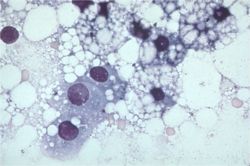Hepatic Lipidosis
| This article is still under construction. |
Signalment
- Indoor cats are more prone to primary hepatic lipidosis.
- Middle-aged cats are more prone.
Description
Hepatic lipidosis is the derangement of lipid and protein metabolism, which occurs in cats and dogs, but more clinically significant in cats. It is important to differentiate primary or idiopathic hepatic lipidosis from secondary hepatic lipidosis.
Primary or idiopathic hepatic lipidosis is most recognised in obese indoor cats following anorexia. It is the most common hepatic disease in North America but it is also becoming more common in Europe. It is an acute hepatopathy with a large accumulation of lipid in hepatocytes, causing the liver to lose its function. The mortality rate is high unless the disease is treated aggressively. The pathogenesis includes a number of factors:
- excessive lipid mobilisation which is induced by anorexia, illness or stress.
- deficiency of dietary proteins and other nutrients, which reduces the liver's capacity to produce transport proteins and to metabolise fat. Recognised nutrient deficiencies include arginine, carnitine, taurine and methionine.
- disturbances in the neurohormonal control of appetite resulting in inappropriate anorexia.
Secondary hepatic lipidosis is a neuroendocrine response in dogs and cats to other diseases for example, pacreatitis, diabetes mellitus, inflammatory bowel disease and primary hyperlipidaemia. Secondary hepatic lipidosis is therefore less closely correlated with obesity and be seen in normal or even thin cats.
Diagnosis
Clinical Signs
- Often obese cats following a sudden starvation
- Anorexia and lethargy
- Jaundice
- Hepatic Encephalopathy
- Diarrhoea (sometimes)
- Palpable hepatomegaly (sometimes)
- Coagulopathies (sometimes)
Laboratory Tests
Biochemistry
- Markedly increased level in alanine
- Low gamma-glutamyltransferase (GGT) concentration
Diagnostic Imaging
Radiography
Abdominal radiography shows a marked hepatomegaly.
Ultrasonography
On ultrasound, an enlarged and diffusely hyperechoeic liver is seen.
Histopathology
Fine needle aspirate of the liver is normally sufficient for a diagnosis. Cytology demonstrates hepatocytes swollen with lipid. Biopsy and culture of the liver tissue is always indicated to determine the underlying cause of the disease.
Treatment
- Intensive treatment of cats is required for best outcome
Nutritional support
- For a period of 4 - 6 weeks.
- This is the most important treatment in hepatic lipidosis. It is vital to ensure that the diet is of adequate calorific content with an increase in protein content. Specific nutrients such as arginine, taurine, or carnitine may also be added.
- This can be done via different feeding systems such as naso-oesophageal tube, oesophagostomy tube, gastrostomy tube.
Hepatic Encephalopathy
- Treat this if presented.
Gastrointestinal drugs
- Anti-emetics and porkinetics such as ranitidine and metaclopromide if vomiting for delayed gastric emptying is present
Fluid therapy
- Intravenous fluid therapy in early stages of disease.
- Blood glucose and electrolytes especially potasium and phosphate should be monitored.
Coagulopathy
- Vitamin K supplement may be required if coagulopathy is significant.
Prognosis
References
- Ettinger, S.J. and Feldman, E. C. (2000) Textbook of Veterinary Internal Medicine Diseases of the Dog and Cat Volume 2 (Fifth Edition) W.B. Saunders Company.
- Hall, E.J, Simpson, J.W. and Williams, D.A. (2005) BSAVA Manual of Canine and Feline Gastroenterology (2nd Edition) BSAVA
- Nelson, R.W. and Couto, C.G. (2009) Small Animal Internal Medicine (Fourth Edition) Mosby Elsevier.
